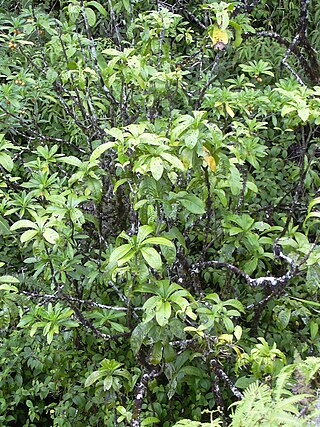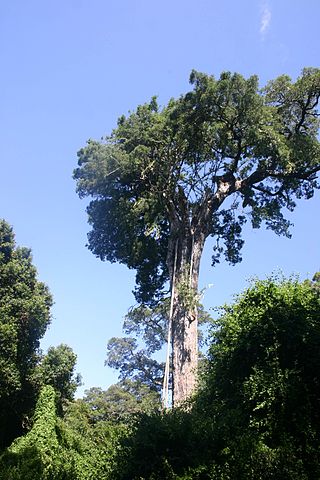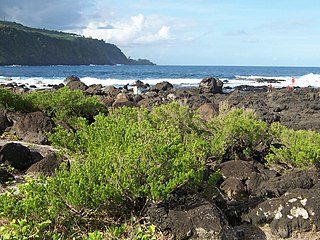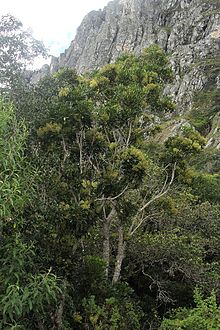
The Araliaceae are a family of flowering plants composed of about 43 genera and around 1500 species consisting of primarily woody plants and some herbaceous plants commonly called the ginseng family. The morphology of Araliaceae varies widely, but it is predominantly distinguishable based on its woody habit, tropical distribution, and the presence of simple umbels.

The Gnaphalieae are a tribe of flowering plants in the family Asteraceae. It is most closely related to the tribes Anthemideae, Astereae, and Calenduleae.

Heptapleurum arboricola is a flowering plant in the family Araliaceae, native to Hainan Province, China and Taiwan. Its common name is dwarf umbrella tree, as it resembles a smaller version of the umbrella tree, Heptapleurum actinophyllum.

Schefflera is a genus of flowering plants in the family Araliaceae with 13 species native to New Zealand and some Pacific islands.

Heptapleurum actinophyllum is a tree in the family Araliaceae. It is native to tropical rainforests and gallery forests in northern and north-eastern Queensland coasts and the Northern Territory of Australia, as well as New Guinea and Java. Common names include Australian umbrella tree, Queensland umbrella tree, octopus tree and amate.

Cussonia is a genus of plants of the family Araliaceae, which is native to the Afrotropics. It originated in Africa and has its center of distribution in South Africa and the Mascarene Islands. Due to their striking habit, they are a conspicuous and easily recognizable group of plants. Their genus name commemorates the botanist Pierre Cusson. The Afro-Malagasy and Asian Schefflera, and Afrotropical Seemannaralia genera are related taxa that share several of its morphological characteristics, among which the leaves borne on the end of branches, inflorescences carried on terminal branches or stems, and reduced leaf complexity in developing inflorescences.

Raukaua is a genus of flowering plants in the family Araliaceae. It has an austral distribution, being indigenous to southern Argentina and Chile, as well as New Zealand and the island of Tasmania.

Plerandra is a genus of flowering plants in the family Araliaceae that has long been considered a synonym of Schefflera, which has been a polyphyletic group.

Heptapleurum taiwanianum is a species of flowering plant in the family Araliaceae, native to Taiwan, where it is scattered throughout coniferous forests at 2,000–3,000 m (6,600–9,800 ft). Growing to 4 m (13 ft) tall by 2.5 m (8.2 ft) broad, it is an evergreen shrub or small tree. Large leaves up to 15 cm (5.9 in) long are composed of up to 11 ovate leaflets arranged radially around a central stalk. Young leaves are covered in silver hairs, while mature leaves have a smooth surface. Sprays of flowers in late summer are followed by dark berries in winter - a valued food source for insects and birds.

Plerandra elegantissima, the false aralia, is a species of flowering plant in the family Araliaceae, native to New Caledonia.

Ceodes umbellifera, synonym Pisonia umbellifera, commonly known as the birdlime tree or bird catcher tree, is a species of plant in the Nyctaginaceae family. The evergreen shrub has soft wood, small pink or yellow flowers, and produces cavate brown fruit throughout the period March to April. The species has been categorized under different genera in its documented lifetime, being reallocated between Pisonia and Ceodes. Its former genus, Pisonia, is named after a Dutch scientist, Willem Piso, and umbellifera is derived from Latin umbelliferum, denoting the species' big, 'shade-carrying' foliage.
Diospyros abyssinica is a tree species in the family Ebenaceae which is native to Sub-Saharan Africa.

Ficus burtt-davyi is a fig species endemic to Southern Africa, belonging to the Mulberry family of Moraceae. It grows in coastal and inland forests up to 1500m, from the vicinity of Mossel Bay in the Southern Cape to southern Mozambique - the forms growing on coastal dunes in the northern part of its range are salt tolerant and form low thickets on the margins of woodland. In the southern and eastern Cape forests the species becomes a strangler or liane, while when found on rocky outcrops and cliffs it usually develops into a rock-splitter.

Maerua angolensis is a 10m tall, occasionally deciduous tree of the Capparaceae or caper family, often growing on termitaria and in thickets fringing seasonal watercourses, up to 1800m. Though never common, it is widespread in tropical Africa and arid regions, being absent from high-rainfall regions.

Rhaphiostylis beninensis is a woody, sprawling or scrambling glabrous, evergreen shrub or liane native to Tropical Africa, belonging to the family Metteniusaceae, and one of 3 species in the genus Rhaphiostylis. It is traditionally used as an anti-inflammatory by the Bantu people of Africa.

Pemphis acidula, commonly known as bantigue or mentigi, is a species of flowering plant in the family Lythraceae. It is the only species in the genus Pemphis.

Heptapleurum ellipticum, commonly known in Australia as the climbing umbrella tree, is a plant in the family Araliaceae native to the Indian subcontinent, Indochina, Malesia, Papuasia and Australia.

















